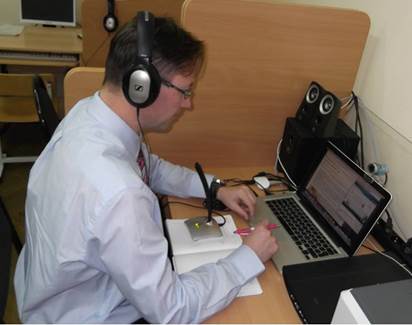Introduction: in this paper we analyze the work of 2nd year students of master’s program in global finance taught in English at a Russian university, who were also taking a class in English for academic purposes including critical thinking and writing. Before the start of the course, the students (16 students) were offered to fill in a questionnaire about their prior experience of learning English. Based on the information received we found that most students had a 10 to 12-year experience of studying in English in China, and very few of them had studied or travelled abroad. Most students obtained their bachelor’s degrees in fields other than foreign languages or humanities.1 About half of the students indicated in the questionnaires that they wished to improve fluency and expand their vocabulary.
Their major master level courses taught in English include advanced courses in macroeconomics, microeconomics, as well as macroeconomic and financial forecasting, econometrics etc. The English language course has an ancillary function – together with research seminar it is aimed at developing critical reading and writing skills in students and providing them with guidance and assistance in their work on their master’s research proposals and dissertations.
In terms of academic program requirements, such an arrangement makes a lot of sense. However, teaching non-native students (from China) in a non-native setting (Russian speaking) using a third language (English) inevitably poses various challenges both to non-native students, who have to overcome recurring problems in communication and to develop necessary academic skills, and to their instructors, who are compelled to make necessary adjustments and demonstrate a certain degree of flexibility. Such challenges mostly derive from the specifics of the learning context, which we are going to discuss further.
Purpose: The purpose of this paper is to analyze the discursive and communicative framework of English for Academic and Specific Purposes taught by a non-native English speaking teacher to non-native students. I will focus on the varying goals and the role of English language in the context of English language learning by non-native students in a non-native setting. I will also discuss the strategies which should be foregrounded in an EAP course to help students achieve their specific goals such as writing a research proposal and subsequently a master’s dissertation. This discussion is an attempt to put the practice of EAP teaching into the theoretical context of English language teaching, and therefore to elaborate on the elements which should be accounted for when developing a pool of materials and exercises for the EAP course. In addition, we believe that our analysis can become a starting point for a future study of writing skills development and content-based instruction in foreign languages.
Throughout our discussion I will refer to the results of a survey conducted after completion of the course. The aim of the survey was to analyze students’ perception of the writing strategies and genres that they were exposed to in their EAP course, their attitude to learning in English and their perception of their language handicaps. It is worth noting that the group of students was not highly homogenous as they had initially reported a variety of circumstances (work, internships, studying abroad) in which they had been exposed to foreign language practice. Realizing that concepts of perception and attitude are to be treated with caution, I still believe it is necessary to mention them since our students contributed to the course practice and their responses can provide us with quite useful insights.
The aim of the paper is not to arrive at some generalizations but rather to address a few specific issues pertinent to teaching and learning academic reading and writing.
English language learning and EAP in a non-native setting: context and goals
Let us briefly describe English language learning context in China. When describing an educational context, we by default imply standard (general) English (school level) and English for Academic Purposes (tertiary level). Whereas at the national level English language teaching in China was introduced into the school curriculum in the 1970s, English classes are also part of university study programs. Regarding the teaching of EAP Bain-Butler, Zhou, and Wei write: «At the graduate studies level, Chinese students are required to be able to write English abstracts for their academic papers in a thesis writing class, that is, an academic writing class for Chinese students in which western-style academic English writing is not the focus» [1, p. 55‒58].
In other words, when Chinese students enrolled in the master’s program at the Russian university, they had little prior experience of learning EAP and reading academic texts in English, yet their knowledge of general English was sufficient to comprehend lectures and participate in seminars taught in English. Macbeth describes such students as intermediate level as a level ‘that serves students who have never written texts based on their reading or cited sources to support their views’ [2, p. 40].
At the same time the purposes and context of the graduate level courses are quite different from those of an EAP course. In the first case students mainly acquire technical, specialist knowledge, they are recipients of knowledge communicated in a foreign language. English is mostly the medium of communication. In an EAP course, on the contrary, students are to use English to develop academic language skills, strategies to process, analyze and create texts in English. Consequently, English is primarily a means of communication and study in an EAP course.
This does not mean that comprehending lectures is a less challenging task. Non-native students have to cope with significant cognitive and linguistic demands affecting their comprehension of lectures. Those demands can be a result of clash of academic culture, varying content and style of lecturing, mixture of conversational features of lectures and academic register conventions and etc. [3, p. 98‒100].
Such variation in terms of language function and use is partly confirmed by the results of our survey in which most students answered positively to the following question:
«Is studying major subjects in English (like macroeconomics, econometrics etc.) easier than studying English language (critical reading and writing) – Yes / No, please, explain».
Two students who answered No wrote: ‘math is hard’ and ‘there are many professional terms which need to be checked and remembered’. In other words, comprehending lectures also posed challenges in terms of content comprehension and the acquisition of special vocabulary. The scope of our EAP course did not include teaching or developing technical vocabulary, as this is mainly done within an ESP course.
How does such context impact the way students communicate in an EAP class? In broad context of the medium vs means paradigm described above, students are likely to switch between two types of communicative behavior – when performing comprehension tasks, they are mostly «outsiders», their role changes to that of «insiders» when the focus of the class is shifted towards interaction with students through questioning, paraphrasing, summarizing etc. [4, p. 111].
Since our students are not fluent in the Russian language and the teachers cannot speak Chinese, students will inevitably resort to online translation to remedy possible failures in communication. Yet, however quick instant translation may be, they soon realize that translation cannot be a substitute for communication (spoken or written) in class. This means that translation will inevitably be supplemented with other strategies which help non-native students maintain meaningful communication. Thus, when English language is the only means of classroom communication students will resort to various compensatory strategies to articulate their thoughts and maintain successful communication: approximation, circumlocution, word-coinage, avoidance etc. [5, p. 194‒198].
Likewise, EAP teachers will also be compelled to adjust their questions and comments to encourage intermediate level students to participate in communication. All things considered (students’ prior experience; English as a primary means of communication, and Russian-speaking environment) a specific task like writing a research proposal may seem quite daunting. For example, students we surveyed reported not being used to reading academic texts, they were struggling with vocabulary and making sense of long sentences and whole paragraphs. From the students’ reflection papers:
«My weakness of vocabulary, this cause me spent to much time on find the meaning of them».
«The first problem is that I can't understand the specific meaning of the article».
What are the implications for teaching practices? It seems unrealistic and largely unnecessary to try to suggest a universal teaching methodology for the context. To accommodate the varying context and the needs of non-native students, relevant teaching methodology should emphasize those skills which could be transferred to related academic fields.
Here we need to circle back to the scope of our course. As T. Dudley-Evans summed it up succinctly: «Academic English for general purposes isolates the skills associated with study activities such as reading academic texts (participating in supervisions, lectures etc.) whereas Academic English for Specific purposes helps students integrate those skills in their actual subject tasks» [4, p. 41]. Thus writing a research proposal or a master’s dissertation would fall under the scope of academic English for specific purposes. However, in practice, teaching how to write a research proposal will, in many cases, be inextricably linked with teaching academic reading, writing summaries and, at times, polishing grammar accuracy – the skillset which will help students navigate in the process of writing their research proposal.
Model for teaching academic reading and writing: elements and process
Genre-awareness approach and discourse-based approach
When we asked our group of students: «Which language skills have been the most difficult for you in English language course? Choose the ones that have demanded the greatest effort from you.»
We got the following results:
- Reading and comprehension tasks – 4 students
- class discussion – analysis of reading – 2 students
- vocabulary and grammar – performing small writing assignments and instant revision – 0 students
- summarizing, paraphrasing and writing – summarizing paragraphs, rephrasing complex sentences – 10 students
The answers reflected the main types of activities performed by students in class. Given the context described above it can be assumed that many students lacked experience of working with source materials. The task of paraphrasing per se may be rather confusing for students as there are no precise criteria which constitute successful paraphrasing. At the same time quoting or introducing other writers’ thoughts should be consistent with the writer’s communicative intention. Ling Shi [6], Hirvela and Du [7, p. 1‒5] underline that paraphrasing is ‘a form of learning’ and «a subjective process of deciding how to make meaning out of the available resources» [6, p. 21]. Moreover, since paraphrasing usually seeks to realize a communicative intention of a writer, there can be no sample or model to replicate. Altogether these underlying pragmatic micro-conditions imply that developing writing techniques is tied to analytical reading. The mechanics of writing and resulting pieces constitute only a part of the whole process of teaching and learning.
What approaches can EAP teachers follow to develop their students’ analytical reading skills? Broadly speaking we can distinguish two teaching approaches, i. e. a genre-based approach and a discourse-based approach [4, p. 87].
Genre awareness has been an essential element of many programs of academic writing, which are usually based on a model text analysis or genre analysis: students are taught to discern the main patterns and elements and replicate them in their writing. Macbeth [2] insists on the usefulness of models especially for novice writers drawing parallels with basic training required in any skill-based profession. The importance of knowledge of genre conventions is central to Braziller and Kleinfeld’s [8] approach to teaching academic writing. Clearly, the overriding objective of academic writing courses is teaching students to create a text consistent with genre (sample text) requirements. However, I do believe that genre awareness approach suits better advanced level students since genre awareness presupposes ability to work with source information which novice students may lack. Besides, genre awareness approach has a narrower scope focusing students’ attention on (a) particular kinds of texts. Students’ ability to work with samples depends to a great extent on their ability to use source texts to incorporate that material into the text being created. To that end, students use such core writing techniques as summarizing, paraphrasing and direct quotation. Acquiring those techniques is critical for novice writers or ‘intermediate level’ students whose work we discuss in this paper.
An approach that accommodates for those academic needs was suggested by Johns and Davies (1983), who developed a methodology based on discourse-based approach using the concepts of macrostructure [9, p. 327] and textual structures which form the coherence of texts [10]. Text is no longer a linguistic object; it is primarily a vehicle of information which contributes to developing new texts [4, p. 87]. Students are taught to analyze the macrostructures of the text, extract the information and identify the recurring patterns and apply this information when working on writing or reading other source texts. Johns and Davies’ method provided another important takeaway for teaching practice as it accounts for variability in text structures. Johns and Paz (1997) who analyzed the practice of summary writing based on Johns and Davies’ methodology, observed that discourse-based approach teaches students to differentiate between texts, and consequently vary their summaries [11, p. 33‒50].
Johns and Davies’ ideas are central to the «reading to write» approach [12, p. 259] as it emphasizes reading skills and connects reading with writing practices. To put differently, discourse-based approach can help achieve a balance between skills and language which is crucial for novice writers. In practice, the scope of discourse-based approach or ‘reading to write’ approach includes many elements (selecting texts, reading comprehension, reading and analysis, writing techniques etc.).
Still, the effectiveness of the learning process does not depend solely on its elements, it is contingent on the way those elements are organized. As Newell, Bloome and Hirvela put it, teaching academic writing is «an interactive process in which the components continuously evolve over time» [13, p. 13] whereas classroom discourse is constructed in a way that facilitates student interaction with the materials through instructional discourse and peer feedback.
Training reading skills within discourse-based approach
In this regard we would like to consider the following questions:
- What texts and tasks were offered to our students to develop their ability to summarize source texts?
- Which instructional factors are crucial to connecting reading and writing in the process of learning?
As it was mentioned above, writing summaries is a form of learning – it is more than meaning-extraction and comprehension, it includes analyzing the text structure, the relationship between its elements and then making choices as to which of those elements should be incorporated and transformed into a new text or not. The task of creating a new text and incorporating other authors’ ideas represents a new rhetorical situation, to which the author responds within confines of a stipulated genre. The writer uses summarizing to draw their own line of reasoning; consequently, summarizing becomes a means of expression and inquiry [8, p. 28‒30].
Though reading for purpose and summarizing is a straightforward task in a situation when a student works on a specific topic (e.g., of a dissertation) and reads relevant academic sources to discuss the topic such conceptualization can be less obvious for novice writers and readers too. To address this issue in our course we used two approaches: one was based on topic-centered texts, and the other based on scholarly texts covering a variety of topics.
The topic-centered approach was rooted in reading and analyzing a group or a collection of academic texts and expert opinion articles covering the same topic (for example, ‘environmental taxes’ or ‘nudge theory’). The choice of topic was motivated by its relevance to modern economic and social context and its wide presence in the media. In other words, I assumed that initially those topics would be familiar for our students. However, only to some extent was this assumption right – in some cases certain texts or passages were not easily accessible to some students, especially in terms of vocabulary and topic analysis. Besides, it was difficult for some students to relate to those topics and to understand their relevance to the social context.
However, exploring one topic through reading and analyzing a group of texts proved to have its benefits, too. It helps demonstrate the range of topic analysis – its main elements, sub-topics and their relationship, i.e. what issues and problems different authors raise when writing on the same topic. This approach also allows students to sketch the conceptual framework of a particular topic, i.e. outline the key terms and notions which form the core of the topic. Though, admittedly, some terms can be difficult to understand through translation, and students need to look them up in monolingual dictionaries. This brings us to the next advantage of this approach, which is the exploration mode. When reading several texts on the same topic students explore a fairly familiar topic and engage in the topic discussion by reading about the topic and immersing by acquiring new terms and notions and getting knowledge about the topic. Thus, the value of this approach is that it transforms reading into a research process.
Despite the advantages it can still be challenging for students to try to synthesize the ideas of various texts into a new piece. As one of the students wrote in a reflection paper:
I can’t make all these three in one essay. I used almost 1 hour to think about why these 3 paragraphs totally different and how can I find one line to connect with these 3 topics. So I made a choice, not use all points just find which points can connect with my main idea.
What if we abandoned the idea of choosing texts according to students’ area of study in favor of a series of unrelated academic texts covering a variety of topics? In our course students were offered several academic texts (academic articles, monographs etc.) on topics in the fields of linguistics, sociology, psychology, and anthropology. For example, one of the texts analyzed the notion of reciprocity and the custom of gift-giving, another text described the changes in the perception of RP in Great Britain and so on.
Compared to the previously discussed topics («environmental taxes» and «nudge theory») these are easier to relate to, as all our students can discuss gift-giving, for example, through the lens of Chinese culture, or even local traditions followed in their native regions or families. Though to some students the very word reciprocity was unfamiliar, through the discussion of the text they managed to get the idea behind the notion and even compared it with the meaning of a Chinese proverb which encapsulates the idea of reciprocity and gift-giving. In a nutshell, selecting academic texts is a crucial step since the choice of topic may affect students’ engagement and ability to interact with the teacher and the group. Suggesting such texts for discussion also allows to extend the topic and to apply it when discussing a related topic. For example, discussion of gift-giving may be easily linked to reciprocity and restaurant tipping.2
The selected texts were still challenging in terms of organization and structural parts due to numerous references, indirect and direct quotes, research data interpretation and so on. But that was also a blessing in disguise because when we identified and analyzed those elements in class students learnt how those elements were connected throughout the text and how the topic is developed in the text. For example, it was important to explain why writers introduced quotes, whether they tried to exemplify some point, to support their claim, to restate it and to specify it etc. In other words, our discussion helped re-conceptualize quoting: as quoting did not just make a text more academic and serious, in fact it helped the writer build a more elaborate discussion and interact with the reader (argue with them, persuade or challenge their views etc.).
The students from our group gave the following feedback.
Q7: The reading materials we were offered at our English language class:
were irrelevant and difficult to discuss ‒ 1
were useful for improving my reading and writing skills ‒ 13
did not correspond to the topic of my research proposal and were not useful for my writing experience.
Other, please explain – 2*
* Some are relatively obscure, but they can enrich extracurricular knowledge;
* were difficult to read and discuss but kind of useful
As we have indicated, this approach implies reading one text, not a series of texts as in the topic-centered model. Another advantage of such reading injections is that they allow a smoother transition from reading to writing.
Factors to consider
The most effective way to approach the texts described above is a question-and-answer discussion as it allows more students to become «insiders», to interact with a text and, most importantly, to share their assumptions and to test them by reacting to their peers’ feedback. Engaging students through questioning also makes the process of learning more tangible which brings me to the third aspect that should be emphasized when working on students’ academic skills.
Tangibility may refer both to written and spoken communication: providing students with printed copies of texts, which they can underline, highlight, or annotate, write the translation or suggest a paraphrase, pose questions etc., encouraging students to restate their comments in the course of discussion, to expand their comments and to relate them to any other structure in the text, asking students to do small follow-up writing tasks after discussion. Another way to make learning more tangible is by enriching written description with visual representation, e. g. when students need to explain the effects of some process they can draw schemes to illustrate cause and effect. Incorporating all these strategies in EAP class helps students develop a critical view of the text.
When we surveyed our students, we got the following feedback on strategies used for reading and analyzing the texts:
While working on my research proposal I learnt how to take notes, sum up the key points in my own words and to incorporate them into the text of my proposal.
7 students chose ‘I was already aware of this strategy and I've always used it for academic writing.’
9 students chose «Yes, it was a new learning strategy useful for my dissertation»
To sum up, we believe that tangibility is one of the factors which are crucial to connecting reading and writing practice.
Instructional conversations, extensively analyzed by Newell and others, are another key factor affecting students’ progress of writing. In real-time teaching, instructional conversations provide scaffolding to the learning process because teachers and students create new knowledge and new understandings [13, p. 17‒19]. This is a very important observation as it suggests that students assume a different role in this process – not only are they explorers and critical readers they also become more visible in this process as they claim their own voice through arguments and reasoning. Students are «positioned as authors with ownership and agency» [13, p. 76]. It is for this reason too that we decided to introduce our students’ feedback to our EAP course.
As Newell and others sum up effective instructional conversations foreground students’ deep thinking and teach them to withhold evaluation. Instruction should aim to introduce students to principles of writing and allow them to explore various cases (contexts) in which these principles are employed, recontextualized or transformed. Most importantly, instructional conversations should evolve «framing student learning of writing as a journey over time», i. e. learning writing will be more effective if it is process-focused not product-focused. In fact, this was one of the challenges for our students who, at the beginning of the course, assumed they would be merely receiving information in the form of lectures and recommendations.
Building up instructional discourse is not based on strict universal rules, on the opposite, it invites variability and gives more latitude in terms of materials and exercise selection. Besides, elaborate construction of instructional discourse with the emphasis on tangibility will enable students to proceed to more complex academic reading and writing tasks.
Conclusion
Teaching non-native students by non-native instructors has long become a ubiquitous practice, and non-native students generally hold a positive attitude towards non-native English-speaking teachers [14, p. 15‒20]. This conclusion was also confirmed by our survey results, all 16 respondents answered positively when asked to evaluate the effect of learning in English:
I feel that when my courses are taught in English it improves my knowledge of English. This experience is useful for daily life and my professional life.
Please choose. Yes / No / I don’t know / Other.
However, as we pointed out in the first section, learning EAP and learning major subjects in English language are two different learning situations. In this paper we evaluated the learning context and some of the constraints non-native students may encounter when learning EAP in a non-native setting. It was established that and EAP course for novice writers tasked with writing a research proposal should put more emphasis on the development of student’s academic skills, i.e. reading source texts and integrating reading and writing practices. Although the components of the course (such as texts, activities and techniques) will evolve, it is essential that such course encourage interaction between the participants, stimulate reflection and critical thinking.
In this paper we contrasted genre-based and discourse-based methods, following the principles of the discourse-based method we developed a teaching model for novice writers. We analyzed the problem of summary writing since the main objective of our model was to provide students with strategies for working with source texts. To develop those strategies, we varied the reading elements of the model: one group of texts was arranged by a topic (topic-centered sequence), other texts covered a variety of topics. To help students navigate through reading more consciously we adopted discourse analysis techniques. We also emphasized the role of such factors as tangibility and instructional discourse as they provide appropriate scaffolding to the learning process.
All in all, perhaps the overall conclusion would be that the idea of a universal model tackling all academic needs at once is unrealistic and EAP teachers may need to draw from all teaching methods and techniques when scaffolding a reading-to-write approach due to varying needs and background experience of their students.
We also asked our students «Do you feel that writing your dissertation in a foreign language limits your ability to discuss the topic of your dissertation in full?» Please choose. Yes / No / Other.
9 students answered positively, 6 students answered negatively. One student chose ‘other’ and wrote: «There is a little bit, because the way of thinking and the way of using will be a little bit different».
Admittedly the question itself looks rather unspecific and it is prone to various interpretations. Yet, this very comment shows that in the course of EAP practice this student changed their perception of reading and writing in a foreign language as distinguished from writing conventions in student’s native language.
I also believe that this discussion is a good starting point for further research of medium-means paradigm – it would be interesting to consider in more detail the changing role of English in the context of content-based (ESP) instruction and communicative adjustments made by course teachers and students. A more exciting and promising line of research could do with the study of writing as social practice across various communicative situations in-class and out of class communication.
References
- Butler D. B., Zhou Y., Wei M. When the culture of learning plays a role in academic English writing. ESP across Cultures. 2013. Vol. 10. No. 10. P. 55‒74.
- Macbeth K. P. Deliberate false provisions: The use and usefulness of models in learning academic writing. Journal of Second Language Writing. 2010. No. 19. P. 33–48.
- Hyland K. Academic discourse. English in a global context. New York, 2009. 215 p.
- Dudley-Evans T., St. John J. Developments in ESP: a multi-disciplinary approach. Cambridge, 2012. 302 p.
- Tarone E. Conscious Communication Strategies in Interlanguage: A Progress Report. On TESOL’77 teaching and learning English as a second language’ Trends in resource and practice. Washington, 1978. P. 194‒201.
- Shi L. Textual appropriation and citing behaviors of university undergraduates. Applied Linguistics. 31. 2010. No. 31. P. 1‒24.
- Hirvela A., Du Q. «Why am I paraphrasing?»: undergraduate ESL writers’ engagement with source-based academic writing and reading. Journal of English for Academic Purposes. 2013. No. 12 (2). 2013. P. 87‒98. DOI:10.1016/j.jeap.2012.11.005
- Braziller A., Kleinfeld E. Bedrock book of genres: a guide and reader. Bedford / St. Martin’s, Second Edition. 608 p.
- Van Dijk T. A. Macrostructures: an interdisciplinary study of global structures in discourse, interaction, and cognition. New Jersey, 1980. 327 p.
- [Electronic resource]. Electron. dan. URL: https://www.teachingenglish.org.uk/professional-development/teachers/managing-resources/articles/text-language-classrooms-talo-tavi (date of acсess 11.07.2023).
- Johns A., Paz D. Text analysis and pedagogical summaries: revisiting Johns and Davies. Functional approaches to written text analysis. Washington, 1997. P. 33‒50.
- Hirvela A. Connecting Reading and Writing in Second Language Writing Instruction. Michigan, 2004. DOI: 10.3998/mpub.23736
- Newell G. E., Bloome D., Hirvela A. Teaching and learning argumentative writing in high school English language arts classrooms. New York, 2015. P. 17‒19.
- Moussu L. M. Native and nonnative English-speaking English as a second language teachers: student attitudes, teacher self-perceptions, and intensive English administrator beliefs and practices. Thesis [Electronic resource]. Electron. dan. URL: https://files.eric.ed.gov/fulltext/ED492599.pdf (date of acсess 11.07.2023).
[1] One of the students is a native speaker of Russian language who had studied in the USA before enrolling to Master’s program.
[2] Source text: Kompter E. A. Gratitude and gift exchange. The psychology of gratitude / Ed. by R. A. Emmons, M. E. McCullough. London: Oxford University Press, 2004. P. 194‒212.












